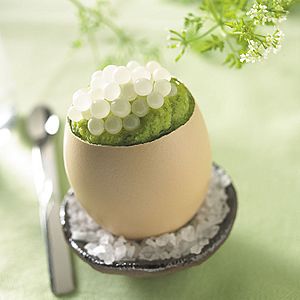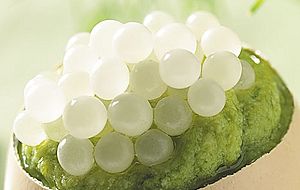Snail caviar facts for kids
Snail caviar, also called escargot caviar or escargot pearls, is a special food made from the eggs of land snails. It's a fancy food, mostly made in France and Poland. Long ago, people in ancient times also enjoyed it, calling it "Pearls of Aphrodite".
Naturally, snail eggs are clear. But after they are prepared, they can be creamy white, pinkish-white, or just white. They are usually small, about 3 to 6 millimeters wide. Some farms that raise snails for food also collect and sell these eggs.
Contents
What is Snail Caviar Like?
Raw snail eggs have a smooth, thin shell that breaks easily. They are sometimes pasteurized to keep them fresh longer. This means heating them to kill germs. But some people say pasteurizing can change their taste.
To keep them fresh without heating, some producers use brine. Brine is salty water. Some even add flavors to the brine to make the caviar taste better.
What Does Snail Caviar Taste Like?
People describe the taste of snail caviar in different ways. Some say it tastes like "baked asparagus" or "baked mushroom" with a "subtle" or "woody" flavor. Others find it has a "strong earthy" taste. It is also crunchier than fish egg caviar.
You can serve snail caviar like other caviars. It often comes with small pieces of toast, sour cream, and champagne. It can also be added to soups.
How Snail Caviar is Produced
Raising snails for food is called heliciculture. Some snail farms collect and prepare snail caviar. They then put it in jars to sell. Farmers often keep snails in special places with controlled temperature and light. This helps the snails lay more eggs.
Snail Reproduction
Snails are hermaphroditic, which means every snail can produce eggs. Snails usually bury their eggs in the soil after laying them. One way to collect the eggs is to put snails in boxes with soil and sand. The eggs are then gathered from there.
Egg Output Comparison
Snails do not lay as many eggs as fish like sturgeon. For example, one snail usually lays about 4 grams of eggs each year. In comparison, a large sturgeon fish can lay up to 18 kilograms (about 40 pounds) of eggs! This is why snail caviar is quite rare.
The Market for Snail Caviar
Snail caviar is a luxury food, and it can be quite expensive. In 1987, a brand called Brut d'Escargot snail caviar sold for about $40 per ounce in the United States. This price was similar to expensive Beluga caviar at that time.
In 2007, a 50-gram jar of De Jaeger brand snail caviar from France cost about €80. By 2014, a 50-gram jar of Viennese Snails brand from Austria sold for over €150. A 50-gram jar is about two tablespoons of product. Some snail farms sell their caviar directly to restaurants.



